Tried making 1/2 rice + 1/2 quinoa (TJ’s mix of white, red, black) in the rice cooker. Not bad! A little chewier than just rice, but I think it might be okay with curries. Hmm…

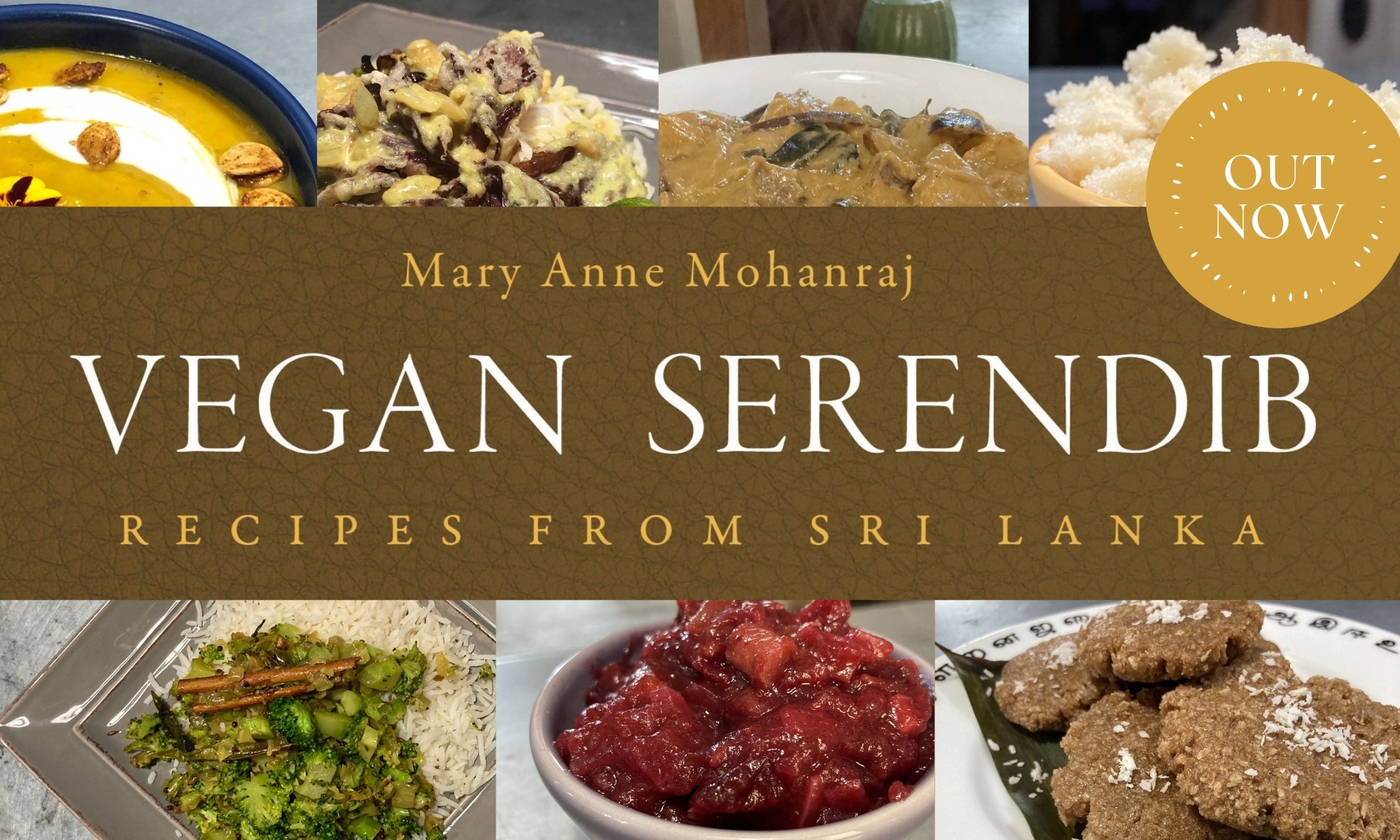
with Mary Anne Mohanraj
Tried making 1/2 rice + 1/2 quinoa (TJ’s mix of white, red, black) in the rice cooker. Not bad! A little chewier than just rice, but I think it might be okay with curries. Hmm…

 (2 hours, serves 6)
(2 hours, serves 6)
This came out SO GOOD. I adapted this from an America’s Test Kitchen Moroccan tagine recipe, amping up the chili powder to my taste, reducing the sweetness, increasing the tang, and switching out sultanas for apricots. The result is somewhere halfway between Sri Lankan and Moroccan food, and absolutely delicious served over couscous. My daughter loved the chicken (though she is not yet a couscous fan). It only has about 30 minutes of active cooking; after that, you’re mostly just letting it simmer while your home fills up with incredible aroma. Clementines for dessert finish this meal off nicely!
4 pounds bone-in chicken thighs
salt and pepper
2 T olive oil
1 large onion, diced small
peel from half a lemon, cut into strips
1 t. chili powder
1/2 t. cumin powder
1/2 t. ginger powder
1/2 t. garlic powder
1/2 t. ground coriander
1/2 t. ground cinnamon
2 c. chicken broth
2 carrots, peeled and cut into diagonal chunks
1 c. sultanas
3 T lemon juice

1. Pat chicken dry and season with salt and pepper (about 1 t. each). Heat oil in extra-large frying pan or Dutch oven over medium-high heat. Add half of chicken and cook until well-browned, about five minutes per side; transfer to large plate. Repeat process with second half of chicken. Pour off all but one tablespoon of fat from the pan.
2. Add onion and lemon to pan and cook, stirring, for about five minutes. Stir in spices and cook a minute or two ore, then add broth, scraping up any browned bits. (If you wanted to add a cup of white wine here, it wouldn’t hurt.)
3. Add chicken to pan along with any accumulated juices and bring to a simmer. Reduce hat to medium, cover, and cook twenty minutes.
4. Stir in carrots, return to simmer, and then re-cover and cook on medium-low for another 40 minutes, until carrots are cooked through.
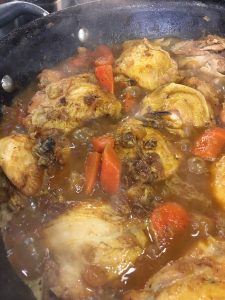
5. Transfer chicken to a bowl tented with aluminum foil and let rest while finishing your sauce. Skim off any excess oil. Discard the lemon peel, stir in the sultanas, and cook about five minutes. Add lemon juice and return the chicken and any juices to pan, simmering a few minutes more to combine. Serve hot over couscous or rice.
(50 minutes, serves 8)
This accompaniment offers a little extra heat and onion-y zing to a plate of rice and curry.
4 medium leeks
1/4 cup oil
1/2 rounded tsp turmeric
1 1/2 rounded tsp chili powder
1 rounded tsp salt
1. Rinse dirt off outside of leeks. Discard any tough or withered leaves, but do use the green portions as well as the white.
2. With a sharp knife, slice the leeks thinly across the stalk, making thin rings / chiffonade; when you’re slicing the green leaves, make a tight bundle in your hands for easier slicing.
3. Wash the sliced leeks very thoroughly. The soil trapped between the leaves won’t actually taste particularly bad, but the grittiness is unpleasant. I recommend not simply running the sliced leeks under a colander—rather, put them in a large bowl of water and wash them vigorously, changing the water at least three times. This is labor-intensive, but well worth it.
4/ Heat oil in a large saucepan and add the leeks. Sauté, stirring for 5 minutes, then add the remaining ingredients and stir until well blended.
5. Cover and cook over low heat for 30 minutes, stirring occasionally. The leeks will reduce in volume. Uncover and cook, stirring, until liquid evaporates and leeks appear slightly oily. Serve hot.
(1 hr 15 min., serves 4)
1 lb. beets, peeled and cubed into bite-size pieces
2-3 T vegetable oil
1 t. salt
1 t. pepper
1 t. coriander seed
1/2 t. cumin seed
1/2 t. black mustard seed
2 T coconut milk
3-5 minced green chilies
1-2 T lime juice
1. Preheat oven to 350. Toss beets in oil, salt, and pepper, and spread flat on a foil-lined baking sheet. Bake 45 minutes.
2. Add coriander seed, cumin seed, and black mustard seed, and bake an additional 15 minutes, until beets are soft and slightly crispy.
3. Combine coconut milk, green chilies, and lime juice in a large bowl, stirring to blend. Add beets and toss until combined. Season to taste with salt and pepper; serve hot with rice or bread. (Pictured here with beef and potato curry and chili leeks.)
 (10 minutes, serves 8)
(10 minutes, serves 8)
This is meant to be an accompaniment—make a batch (it keeps for weeks in the fridge) and then put a teaspoon or two on your plate with your rice/bread and curries. In Sri Lanka, they would just use straight up chili powder, instead of a mix of chili powder and paprika, which would make it fiercely spicy. If I were only going to make one accompaniment for the rest of my life, pol sambol would be my choice, although seeni sambol would be a very close second.
1 cup desiccated unsweetened coconut
3 TBL hot milk (I heat mine in the microwave)
1 rounded tsp salt
1 rounded tsp chili powder
2 rounded tsp paprika
2-3 TBL lime juice, to taste
1 medium onion, minced fine
1. Reconstitute coconut in a large bowl with the hot milk. I recommend using your fingers to squeeze the milk through the coconut. (If you can get fresh or frozen grated coconut, that is, of course, even better, and you can skip this step.)

2. Add salt, chili powder, paprika, lime juice, and onion. Mix thoroughly with your hand, rubbing ingredients together until well blended.

Note: If you don’t feel that your onion is minced sufficiently fine (ideally, to match the texture of the coconut), you can use a food processor to chop it more finely, or grind it with a mortar and pestle. You can grind just the onions, or the whole mixture.
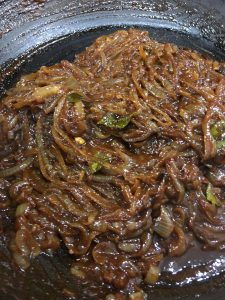 (1 hour, serves 8)
(1 hour, serves 8)
The Sri Lankan version of caramelized onions is sweet, spicy, and tangy. It’s important to cook the onions slowly—all the liquid in the onion must evaporate if you want the sambol to keep well. Made properly, this dish can keep for several weeks in the fridge, so you can enjoy a little with each curry meal for quite a long time. An essential accompaniment for hoppers, and delicious with many other meals.
1/2 cup vegetable oil
1 TBL Maldive fish, powdered (optional)
4 medium onions, finely sliced
2 rounded tsp chili powder
1 inch cinnamon stick
3 cloves
3 cardamom pods
1 stalk curry leaves
1 tsp salt, or to taste
2 TBL tamarind pulp
2 TBL sugar
1. Heat oil in a large frying pan and start sautéing onions on medium-low (with Maldive fish, if using). Add cinnamon, cloves, cardamom, curry leaves, and chill powder; continue cooking, stirring occasionally, until soft and transparent, about 30 minutes.
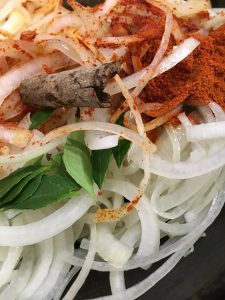

2. After about 30 minutes, cover pan, and simmer 10 minutes.
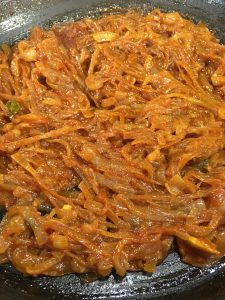
3. Uncover pan and continue simmering, stirring occasionally, until liquid evaporates and oil starts to separate from other ingredients. Season to taste with salt.
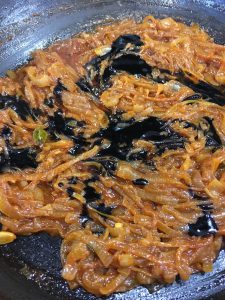
4. Remove from heat, stir in sugar and tamarind pulp and allow to cool before putting in a clean dry jar. Use in small quantities.
 If I had to pick the perfect Sri Lankan meal, this would be it. There’s nothing like breaking off a crisp piece of hopper, dipping it into broken egg, and scooping up some curry and a bit of seeni sambol. Delectable.
If I had to pick the perfect Sri Lankan meal, this would be it. There’s nothing like breaking off a crisp piece of hopper, dipping it into broken egg, and scooping up some curry and a bit of seeni sambol. Delectable.
These rice flour pancakes have a unique shape; fermented batter is swirled in a special small hemispherical pan, so you end up with a soft, spongy center, and lacey, crispy sides — that contrast is the true glory of the hopper. Typically you’d make one egg hopper per person, plus another plain hopper or two, and maybe a sweet hopper to finish up.

If you don’t have a hopper pan, you can make hoppers in a regular frying pan; you just won’t get quite as much of the crispy sides. It’s a little time-consuming to make hoppers, since each one must be individually steamed for a few minutes, but with practice, you can have four hopper pans going on a stove at once. I’d recommend starting with just one pan at a time, though! Serve with curry and seeni sambol.
2 cups South Asian white or red rice flour (or a mix of rice and wheat flour)
1 tsp sugar
pinch of baking powder
1/2 tsp salt
2 cups coconut milk
eggs for egg hoppers
extra coconut milk and jaggery for sweet hoppers
1. Mix first five ingredients thoroughly in a large bowl, cover, and set in a warm, turned-off oven to ferment overnight. (In a cold climate, fermentation may not occur without a little help—I turn my oven on to 250 degrees, and when it’s reached temperature, turn it off and put the covered bowl in the oven to stay warm.)
2. Mix again, adding water if necessary to make a quite thin, pourable batter.
3. Heat pan (grease if not non-stick) on medium, and when it’s hot, pour about 1/3 cup batter into the center. Pick up the pan immediately and swirl the batter around, coating the cooking surface. The sides of the hopper should end up with holes in them: thin, lacy, and crisp – if the batter is coating the pan more thickly, mix in some hot water to thin it down. Cover and let cook for 2-4 minutes — you’ll know it’s ready when the sides have started to brown and the center is thoroughly cooked. A silicone spatula will help with getting the hopper out of the pan.

4. For egg hoppers, after swirling, crack an egg in the center before covering. The egg will cook as the hopper does, finishing in about 3-4 minutes.


5. For sweet hoppers, after swirling, add a tablespoon of coconut milk and a teaspoon of jaggery to the center of the pan, then cook as usual.
If you don’t use all the batter right away, you can store it in the fridge, but it will keep rising, so make sure there’s some room in your storage container for that, and then you’ll want to thin it back down to pouring consistency with another 1/4 – 1/2 c. of water before use.
NOTE: If you use instant hopper mix, I found that a packet (about 3 cups of mix) used 2 cans of coconut milk plus 2 – 2 1/2 cups of water.

 (2 hours, serves 8)
(2 hours, serves 8)
This is very similar to a traditional British beef stew, but the Sri Lankan version adds vinegar and peppercorns for a distinctly different flavor. I love to chew on the peppercorns for a bit of sharp bite, and will sometimes add even more peppercorns to the pot.
3 lbs beef chuck, cubed, large pieces of fat removed
2 cups beef stock
2 TBL ghee or vegetable oil
2-inch piece cinnamon stick
8 cloves
40 peppercorns
1-2 tsp salt
2 cups vinegar
3 medium onions, peeled and cut in eighths
2-3 large potatoes, peeled and cut in large pieces
4 carrots, cut in large pieces
1. In a large stew pan, heat the oil on high, add the meat and brown on all sides (avoid crowding the pan, as that will cause it to steam instead of browning—do the meat in two batches if necessary).

2. When nicely browned, pour in beef stock and a sufficient quantity of the water to cover the meat. Add the cinnamon, cloves, peppercorns, salt, and vinegar. Bring to a boil, then cover, turn down heat to low, and let simmer for 30 minutes.
3. Add the vegetables, turn the heat to high long enough for the stew to come to boil, then turn it back down to low and continue to cook, uncovered, until the meat is tender and the vegetables are cooked through, about an hour. You’re aiming for the sauce being reduced to a thick gravy, so add water or cook the liquid off as needed. Serve hot, with hearty white bread or rice.
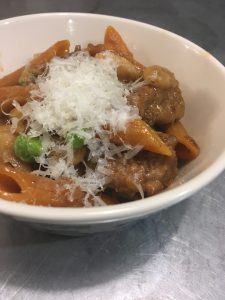 (45 minutes, serves 6)
(45 minutes, serves 6)
You may remember that I’m on something of a kick to convince the kids to eat beans, as part of an attempt to get us to eat healthier and also less carnivorously. (I don’t know that we’re likely to ever go all-vegetarian, given how much we like meat and how weak our wills are, but we can at least reduce how much meat we eat, which is better than nothing, for ourselves, for the animals, for the planet.) You may also remember that pasta with broccoli rabe and cannellini beans was a dismal failure — the broccoli rabe was so bitter that the kids declared the entire dish inedible. (Kevin and I liked it.)
 For take two, I figured I would coax them into it. I’d use flavors I knew they liked (chicken broth and Parmesan), I’d add in Italian sausage, and I’d cut the amount of beans in half, so they’d be a little less overwhelming. Success was…mixed. I thought it was delicious, though the peas were perhaps a little too similar in texture to the beans. (Should’ve stuck with my original plan to serve this with broccolini, but I forgot to pick some up at the store, oops.) Anand ate his entire plate and had seconds, hooray!
For take two, I figured I would coax them into it. I’d use flavors I knew they liked (chicken broth and Parmesan), I’d add in Italian sausage, and I’d cut the amount of beans in half, so they’d be a little less overwhelming. Success was…mixed. I thought it was delicious, though the peas were perhaps a little too similar in texture to the beans. (Should’ve stuck with my original plan to serve this with broccolini, but I forgot to pick some up at the store, oops.) Anand ate his entire plate and had seconds, hooray!
Kavya, sadly, avoided both beans and peas (she did have two bites of each, to show willing, but that was all I could talk her into), ate lots of sausage, and said that even her beloved pasta tasted strange to her. Ah well. I’ll probably try making this or something like it a few more times and hope that she gets more accustomed to the flavors.
2 T olive oil
1 onion, chopped
3 cloves garlic, minced
1 lb. Italian sausage, skin cut off
1/2 c. white wine
2 c. chicken broth
1 c. canned cannellini beans, drained and rinsed
1/2 c. grated Parmesan
1/2 t. crushed red pepper
2 c. cooked pasta (I used veggie penne)
1/2 c. frozen peas
additional Parmesan for grating on top
1. Sauté onion in olive oil on medium-high, stirring, until softened. Add garlic and continue sautéing until onions are golden-translucent.
2. Turn heat to high, add Italian sausage and break up, stirring, into small chunks, letting sausage brown a little.

3. After a few minutes, add white wine to deglaze the pan, scraping up any browned bits. Add chicken broth and beans, stirring to combine. Add Parmesan and crushed red pepper. Simmer on medium until sausage is cooked through, 5-10 more minutes. By that point, the liquid should have reduced to a nice thick sauce.

4. Stir in pasta and frozen peas and cook a few minutes more, until well combined. Serve hot, passing additional Parmesan for grating.
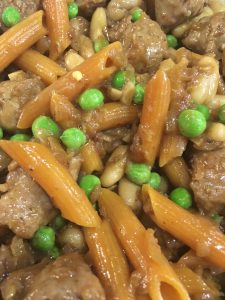
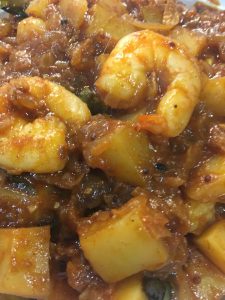 (30 minutes, serves 6)
(30 minutes, serves 6)
I had a busy work day yesterday, so it was six o’clock before I had a chance to look at the calendar and remind myself what the evening plans were — only to be reminded that I’d planned to go to a refugee-supporting potluck, which started at six o’clock!
We were supposed to bring something to share from countries that might be affected by a refugee ban, so I obviously wanted to bring Sri Lankan food. But I needed something I could make fast!
I also ideally wanted to bring a savory dish, and something with protein, because potlucks tend to lean heavy towards the sweets and the starches. I poked around in the freezer and pantry, confirmed I had frozen shrimp and russet potatoes; that meant I had a plan in place. By 6:30, I was transferring the curry into a disposable container and heading out the door; just a few minutes later, people were tucking into the food enthusiastically. Yum.
2 T vegetable oil
1 large onion, chopped fine
2 T ginger-garlic paste
1 t. mustard seed
1 t. cumin seed
1 stalk curry leaves
1 T chili powder
1 t. Sri Lankan curry powder
1/4 c. ketchup
1 t. salt
1 lb. frozen peeled raw shrimp
1 lb. russet potatoes, peeled and cubed small
1 T lime juice
1. Put potato cubes in a microwave-safe bowl with water to cover and microwave 5 minutes to par-boil. Let sit until needed.
2. While potatoes are microwaving, sauté onions in oil or ghee with ginger-garlic paste, mustard seed, cumin seed, and curry leaves, stirring on high, until onions are golden-translucent, about 5 minutes.

3. Stir in chili powder, curry powder, ketchup, and salt. Stir a minute or two to blend.

4. Add potatoes with their cooking water. Add shrimp (still frozen is fine). Continue cooking on high, stirring occasionally, until shrimp are cooked and pink, and potatoes are soft.

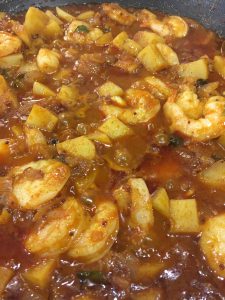
5. Add lime juice, give a final stir or two, and serve hot with rice or bread.